After years of war and strife, the island of Zhong-Guo in the Middle Kingdom has been reunited under the rule of law, and the noble houses that inhabit it are rushing to cross the seas and claim lands in surrounding areas. The former Empire is ready to be cultivated once more, but if each house hopes to earn a bountiful harvest, they will have to pay a price and cross the dangerous waters that lie between them and their goal.
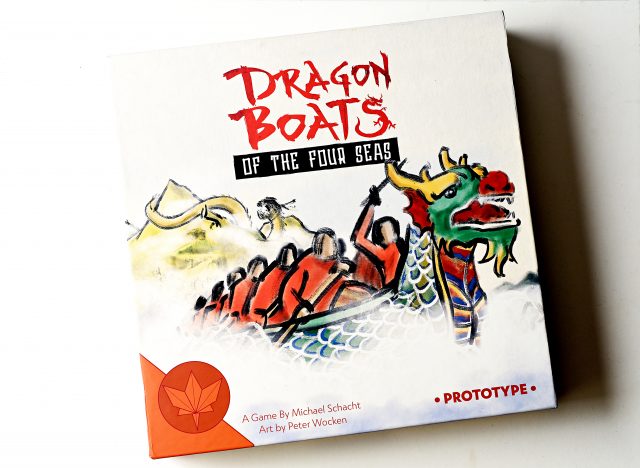 If you’ve heard of Maple Games, I wouldn’t be surprised at all. Despite not having a published game yet, they are headed by Daryl Andrews, who designed Sagrada, and the fledgling Canadian company has put together a stellar team, including artist Peter Wocken and developer Jessica Davis. Their debut title, Dragon Boats of the Four Seas was designed by Michael Schacht, and while we don’t normally cover Kickstarter games, we got a chance to try it in its completed form and feel confident giving our opinion here.
If you’ve heard of Maple Games, I wouldn’t be surprised at all. Despite not having a published game yet, they are headed by Daryl Andrews, who designed Sagrada, and the fledgling Canadian company has put together a stellar team, including artist Peter Wocken and developer Jessica Davis. Their debut title, Dragon Boats of the Four Seas was designed by Michael Schacht, and while we don’t normally cover Kickstarter games, we got a chance to try it in its completed form and feel confident giving our opinion here.
The main concept of Dragon Boats is to pay for passage for your Farmers to reach one of the four islands surrounding Zhong-Guo and harvest different goods from their shores. You’ll earn rewards for collecting sets of goods as well as building bigger networks of farms. While the rules themselves are very simple, there are a lot of interesting and challenging decisions to make, and many different paths to victory.
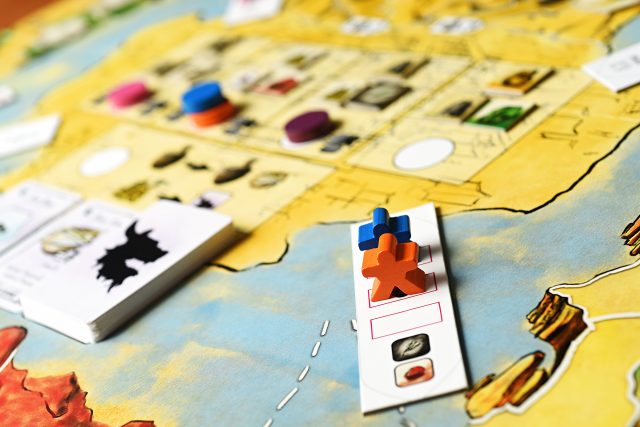 The game is played over a series of rounds (usually six) and the rounds are broken up into phases. The island of Zhong-Guo has five different Markets that will each house a different variety of three Goods or allow for special actions. There are also four different docks which will house Dragon Boats preparing to cross the seas to the islands on the other side. Players begin the game with four Bidding discs, 10 Farmers, and a personal board to track their money and store any Goods they collect. Before a game starts, the round tracker cards are laid out and players must place one of their Bidding discs on one of the round cards 2-5. The higher they place their disc, the later in the game they’ll gain access to a fourth bid, but the better the starting resources they’ll get. Right off the bat you’ll have a tough decision to make.
The game is played over a series of rounds (usually six) and the rounds are broken up into phases. The island of Zhong-Guo has five different Markets that will each house a different variety of three Goods or allow for special actions. There are also four different docks which will house Dragon Boats preparing to cross the seas to the islands on the other side. Players begin the game with four Bidding discs, 10 Farmers, and a personal board to track their money and store any Goods they collect. Before a game starts, the round tracker cards are laid out and players must place one of their Bidding discs on one of the round cards 2-5. The higher they place their disc, the later in the game they’ll gain access to a fourth bid, but the better the starting resources they’ll get. Right off the bat you’ll have a tough decision to make.
The Bidding phase starts each round. I, turn, players can place their Bidding discs on the different Markets of Zhong-Guo, or on their personal board to gain money through a personal action. Multiple players can go to the same Market, simply stacking their discs as they visit them. Each Market will have a full compliment of three Goods randomly placed there at the start of a round, so some may be more popular than others. Once all of the Bidding has been done, it’s time to pay the piper!
 During the Pay phase the Markets are assessed from left to right. The player with the topmost Bidding disc gets the opportunity to pay first for one of the Goods at the Market, but they must pay the value in coins equal to the number of discs there. The more popular a Market, the more expansive it is to buy there. If a Market is particularly popular, there may be more discs than Goods. In that case a player may not even get the chance to pay for one. However, it’s not a total loss. If a player can’t or chooses not to buy a Good, they can take their disc back for a coin. The fifth Market allows players two different actions and they’re able to do both if they so desire. First, they can trade in a Good for a random Good from the bag plus a Food card (we’ll get there), next, they can spend a Treasure card to take a Bonus card.
During the Pay phase the Markets are assessed from left to right. The player with the topmost Bidding disc gets the opportunity to pay first for one of the Goods at the Market, but they must pay the value in coins equal to the number of discs there. The more popular a Market, the more expansive it is to buy there. If a Market is particularly popular, there may be more discs than Goods. In that case a player may not even get the chance to pay for one. However, it’s not a total loss. If a player can’t or chooses not to buy a Good, they can take their disc back for a coin. The fifth Market allows players two different actions and they’re able to do both if they so desire. First, they can trade in a Good for a random Good from the bag plus a Food card (we’ll get there), next, they can spend a Treasure card to take a Bonus card.
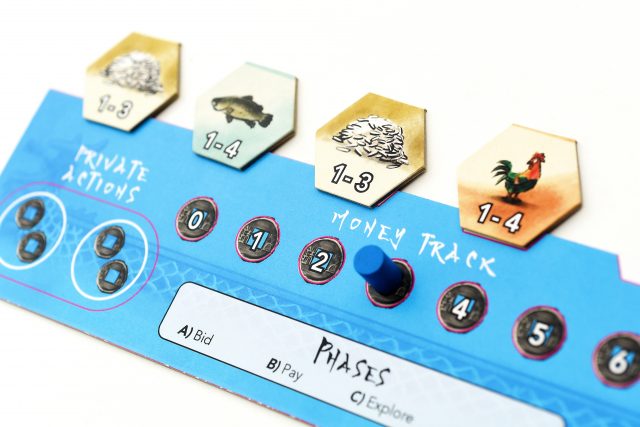 Now, you’re obviously collecting all of these Goods for a reason, and on a turn, you’re able to spend Goods to pay for passage for one of your Farmers on one of the Boats docked on Zhong-Guo, or to take the Mountain path to acquire special tiles. Each boat has a requirement of two goods to pay for a seat, and space for three different Farmers. They also have an initiative number which tells you the order they will sail in at the end of the round. Choosing where to sit on a boat comes with some important things to consider. The front seat allows you to get off the boat first and have more options when choosing where to farm on the new island. At the back of the boat, you take control of the rudder and can decide which of two sea routes to take, impacting which island you’ll land on. The middle position comes with no special abilities, however you pay one less Good for that spot on the boat. You can also choose to stay on Zhong-Guo and spend three Goods to follow one of two mountain paths. These paths allow you to gain special tiles which can help you during the game or in end game scoring.
Now, you’re obviously collecting all of these Goods for a reason, and on a turn, you’re able to spend Goods to pay for passage for one of your Farmers on one of the Boats docked on Zhong-Guo, or to take the Mountain path to acquire special tiles. Each boat has a requirement of two goods to pay for a seat, and space for three different Farmers. They also have an initiative number which tells you the order they will sail in at the end of the round. Choosing where to sit on a boat comes with some important things to consider. The front seat allows you to get off the boat first and have more options when choosing where to farm on the new island. At the back of the boat, you take control of the rudder and can decide which of two sea routes to take, impacting which island you’ll land on. The middle position comes with no special abilities, however you pay one less Good for that spot on the boat. You can also choose to stay on Zhong-Guo and spend three Goods to follow one of two mountain paths. These paths allow you to gain special tiles which can help you during the game or in end game scoring.
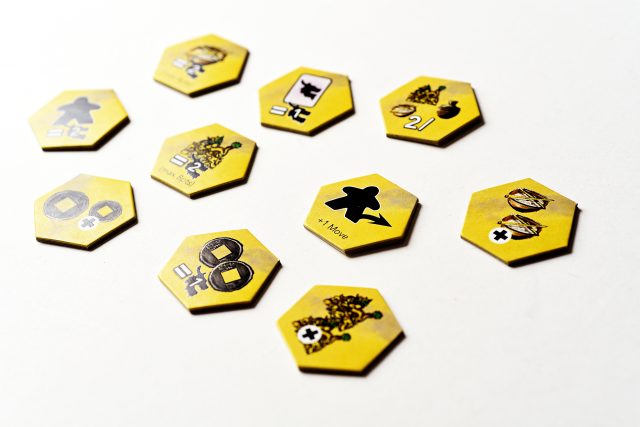 All of the travel takes place during the Explore phase. The mountain paths are resolved first, followed by the boats in descending numerical order. Boats will sail if they have at least two Farmers on them, otherwise they’ll will stay at the dock until a later round. If you took the middle seat (for one less good) and no one took the front seat of a boat you’re on, you get the benefit of embarking first. If you’re in the middle and no one took the back seat, you can take control of the rudder. It’s a risk that you may have less control, but there can be some benefits to going in the middle. As you travel along the mountain paths or on the islands paths after the boats have landed, you get three points of movement, however you can extend that by consuming food, allowing you to continue your journey. Different spots of the path yield rewards like Treasure, Coins, Food, or random Goods. When your Farmer takes up a plot of land, they will claim their space on the board and take the Farm tile. At the end of the game you’ll earn points for the sets of Farm tiles collected and the Farmers you’ve managed to clump together.
All of the travel takes place during the Explore phase. The mountain paths are resolved first, followed by the boats in descending numerical order. Boats will sail if they have at least two Farmers on them, otherwise they’ll will stay at the dock until a later round. If you took the middle seat (for one less good) and no one took the front seat of a boat you’re on, you get the benefit of embarking first. If you’re in the middle and no one took the back seat, you can take control of the rudder. It’s a risk that you may have less control, but there can be some benefits to going in the middle. As you travel along the mountain paths or on the islands paths after the boats have landed, you get three points of movement, however you can extend that by consuming food, allowing you to continue your journey. Different spots of the path yield rewards like Treasure, Coins, Food, or random Goods. When your Farmer takes up a plot of land, they will claim their space on the board and take the Farm tile. At the end of the game you’ll earn points for the sets of Farm tiles collected and the Farmers you’ve managed to clump together.
The Storage phase ends the round, and forces you to discard down to three Goods, refill the Markets, bring the boats back to Zhong-Guo, and prepare for the next round.
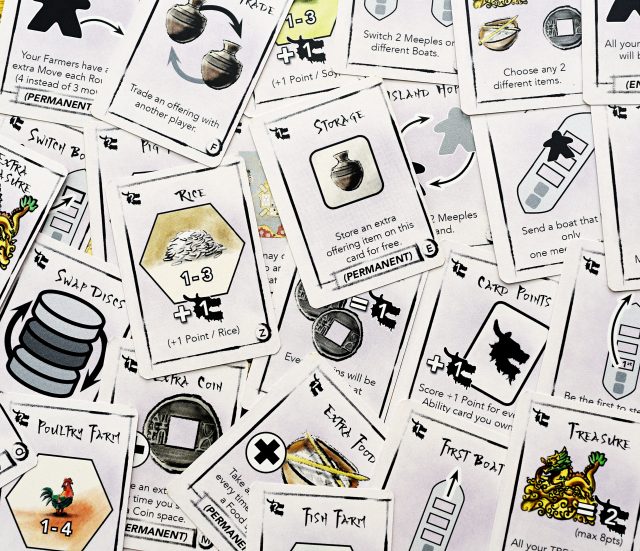 During the sixth round, all the boats sail, and then it’s time to evaluate the final score. You’ll get points for Farm tiles, Farmer Groups, and any bonus cards you’ve collected throughout the game.
During the sixth round, all the boats sail, and then it’s time to evaluate the final score. You’ll get points for Farm tiles, Farmer Groups, and any bonus cards you’ve collected throughout the game.
It’s important to note that the images you see in this article represent a prototype and the final components may differ in the final product. Having said that, there is very little about Dragon Boats of the Four Seas that feels incomplete. It is a well-balanced, tight, strategic game reminiscent of classic titles like Der Spiecherstadt, El Grande, and Goa. It’s not overly flashy, but it shines in the gameplay department. I love a game where the demand for goods, drives up the price, and players have to agonize over the value, while occasionally finding the odd bargain. While I think this game will particularly appeal to fans of old-school Euros, there is a lot to enjoy for gamers of all stripes. When you consider the accessible rules, I can see Dragon Boats being a runaway hit. Considering this is the first title for Maple Games, I expect big things from this company for years to come.
Definitely check out Dragon Boats of the Four Seas when it hits Kickstarter on October 2nd.
test